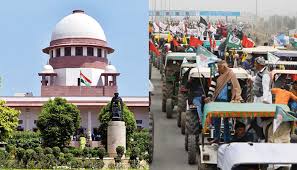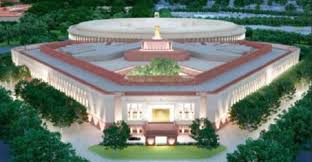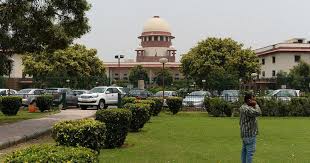Feature
Retired judge to re-evaluate DJS exam answer sheets: SC

New Delhi: The Supreme Court on Monday said it will appoint a retired judge of the apex court to re-evaluate the answer sheets of the Delhi Judicial Services (DJS) main exam of 2014 which have come under cloud for alleged “unreasonable and arbitrary” evaluation.
The apex court bench of Justice Dipak Misra and Justice Prafulla C. Pant said the judge they would appoint would be the “strictest” judge.
“We will appoint a strictest judge,” Justice Misra said directing the next hearing of the matter on November 6 when the court would name the judge.
The court said the after the re-evaluation of the answer sheet, the judge would summit the report to it.
Saying that nothing could be decided on assumption and presumption, the court did not accept Bhushan’s submission that some of the toppers in the judicial services examination of other states were unsuccessful in DJS 2014 exam.
“We don’t accept Prashant Bhushan’s submission that toppers will always be toppers,” said the bench.
The court order came on a PIL by the NGO Centre for Public Interest Litigation (CPIL) which has sought the quashing of the main exam result and re-evaluation of the answer-sheets by an independent expert committee headed by a retired judge of the high court.
The court by its August 4 order declined to stay the interview of the successful candidate, saying: “We are not inclined to stay the interview. However, the results would be dependent on the ultimate outcome of the petition.”
Challenging the main 2014 DJS exam on the grounds of “selection and evaluation” process being unreasonable and arbitrary” and in “violation of Article 14”, the PIL has contended that some of the candidates in their representation have said that they were “topper and gold medallist in their respective law colleges”.
The PIL said the successful candidates’ ranked number one and three are children of sitting judges of the high court.
The PIL petitioner has told the court that for 80 vacancies of DJS, 9,033 candidate appeared in the preliminary exam. A total of 659 appeared in the main exams held on October 10 and 11, 2014.
Of the 80 vacancies – 55 were in general category and 25 in reserved category.
The results that were declared on May 1 – eight months after the examination – only 15 candidate (13 from general category and two from reserved category) were selected for interview to be held on August 6.
The CPIL has told the court that a number of candidates who appeared in the exams were already serving as judicial officers in subordinate judiciary in different states and 10 candidates were those who had topped the judicial services examination in their respective states.
The court has been told that 68 candidate who appeared in DJS examination earlier cleared the judicial services examination in their respective “most of them are sitting judges in their respective states”.
The NGO has also told the court: “At least six candidate, who have not been selected for the interview, are the first rank holder in the judicial exams of their respective state, and at least three candidate are second rank holders in their respective (state) judicial exams.”
Entertainment
Meghalaya Reserves Legalized Gambling and Sports Betting for Tourists

The State Scores Extra High on Gaming-Friendly Industry Index
Meghalaya scored 92.85 out of 100 possible points in a Gaming Industry Index and proved to be India’s most gaming-friendly state following its recent profound legislation changes over the field allowing land-based and online gaming, including games of chance, under a licensing regime.
The index by the UK India Business Council (UKIBC) uses a scale of 0 to 100 to measure the level of legalisation on gambling and betting achieved by a state based on the scores over a set of seven different games – lottery, horse racing, betting on sports, poker, rummy, casino and fantasy sports
Starting from February last year, Meghalaya became the third state in India’s northeast to legalise gambling and betting after Sikkim and Nagaland. After consultations with the UKIBC, the state proceeded with the adoption of the Meghalaya Regulation of Gaming Act, 2021 and the nullification of the Meghalaya Prevention of Gambling Act, 1970. Subsequently in December, the Meghalaya Regulation of Gaming Rules, 2021 were notified and came into force.
All for the Tourists
The move to legalise and license various forms of offline and online betting and gambling in Meghalaya is aimed at boosting tourism and creating jobs, and altogether raising taxation revenues for the northeastern state. At the same time, the opportunities to bet and gamble legally will be reserved only for tourists and visitors.
“We came out with a Gaming Act and subsequently framed the Regulation of Gaming Rules, 2021. The government will accordingly issue licenses to operate games of skill and chance, both online and offline,” said James P. K. Sangma, Meghalaya State Law and Taxation Minister speaking in the capital city of Shillong. “But the legalized gambling and gaming will only be for tourists and not residents of Meghalaya,” he continued.
To be allowed to play, tourists and people visiting the state for work or business purposes will have to prove their non-resident status by presenting appropriate documents, in a process similar to a bank KYC (Know Your Customer) procedure.
Meghalaya Reaches Out to a Vast Market
With 140 millions of people in India estimated to bet regularly on sports, and a total of 370 million desi bettors around prominent sporting events, as per data from one of the latest reports by Esse N Videri, Meghalaya is set to reach out and take a piece of a vast market.
Estimates on the financial value of India’s sports betting market, combined across all types of offline channels and online sports and cricket predictions and betting platforms, speak about amounts between $130 and $150 billion (roughly between ₹9.7 and ₹11.5 lakh crore).
Andhra Pradesh, Telangana and Delhi are shown to deliver the highest number of bettors and Meghalaya can count on substantial tourists flow from their betting circles. The sports betting communities of Karnataka, Maharashtra, Uttar Pradesh and Haryana are also not to be underestimated.
Among the sports, cricket is most popular, registering 68 percent of the total bet count analyzed by Esse N Videri. Football takes second position with 11 percent of the bets, followed by betting on FIFA at 7 percent and on eCricket at 5 percent. The last position in the Top 5 of popular sports for betting in India is taken by tennis with 3 percent of the bet count.
Local Citizens will Still have Their Teer Betting
Meghalaya residents will still be permitted to participate in teer betting over arrow-shooting results. Teer is a traditional method of gambling, somewhat similar to a lottery draw, and held under the rules of the Meghalaya Regulation of the Game of Arrow Shooting and the Sale of Teer Tickets Act, 2018.
Teer includes bettors wagering on the number of arrows that reach the target which is placed about 50 meters away from a team of 20 archers positioned in a semicircle.
The archers shoot volleys of arrows at the target for ten minutes, and players place their bets choosing a number between 0 and 99 trying to guess the last two digits of the number of arrows that successfully pierce the target.
If, for example, the number of hits is 256, anyone who has bet on 56 wins an amount eight times bigger than their wager.





















